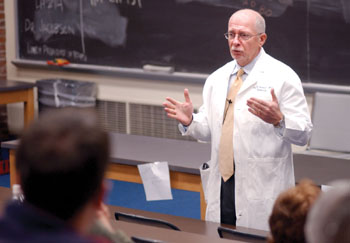
Overactive bladder affects 33 million Americans and is defined as urinary urgency. Photo illustration by John Howser
Gotta go? Study may uncover relief for overactive bladders
You’ve seen the catchy ads on TV with people who “gotta go right now” springing up during awkward social moments to dash to the restroom. The ads are a tongue-in-cheek way to promote medications for an ever-growing market of Americans suffering from overactive bladder (OAB) and urinary incontinence.
Urinary incontinence is not a life-threatening disease, but rather a quality of life disease. “The destruction of quality of life can be dramatic,” said Dr. Roger Dmochowski, professor of Urologic Surgery. It is estimated that the number of Americans suffering from urinary incontinence disease will increase dramatically in the coming decades as baby boomers age.
A new bladder control drug studied at Vanderbilt University Medical Center and several other U.S. sites offers the tens-of-millions of Americans suffering from urinary incontinence issues improved therapy with fewer side effects than other previously available medications.
The new drug, oxybutynin, marketed under the name Oxytrol, is absorbed through the skin through a transdermal system rather than taken orally, and offers fewer systemic or drying side effects while providing the same benefits as current oral medications for treating overactive bladders.
Study findings on the new drug were presented recently at the International Continence Society in Florence, Italy and just published in abstract form in the journal Neurology and Urodynamics.
“It’s encouraging that we are able to achieve the same efficacy as the current oral medication on the market, yet maintain a drying side effect profile comparable to a placebo. Additionally, the oxybutynin transdermal system has the lowest reported incidence rate of drying side effects from large multi-center trials,” said Dmochowski, the study’s lead author.
Overactive bladder affects 33 million Americans and is defined as urinary urgency, with or without urge incontinence, and usually includes urinary frequency and nocturia (excessive urination at night). The condition is characterized by involuntary bladder muscle contractions that often a patient cannot suppress, resulting in involuntary loss of urine.
“The principal limitation of oral OAB therapies are bothersome drying side effects, such as dry mouth and constipation, which are also the leading cause of treatment discontinuation among OAB medication users. By delivering oxybutynin into the bloodstream and bypassing the gastrointestinal system, the metabolite that exacerbates these side effects is drastically reduced,” Dmochowski said.
For the study, investigators randomized 361 adult patients after a two-week washout period of their current OAB therapy to a 12-week double-blind treatment with twice-weekly oxybutynin transdermal medication, daily oral medication, or placebo. Patients’ evaluations included change from baseline in urinary diary symptoms, incontinence specific quality-of-life, and safety.
Patients in the oxybutynin transdermal group and the oral medication group did not show a statistically significant difference in efficacy parameters, which were measured by the decrease in daily urinary incontinence episodes, decrease in daily frequency, increase in urinary void volume and improved quality of life, but did have a statistically significant reduction in drug-related side effects.
“Transdermal oxybutynin is as effective as the leading oral therapy with fewer side effects because of its unique transdermal delivery system,” Dmochowski said. “By delivering oxybutynin into the blood stream and bypassing the gastrointestinal system, we also minimize the potential for drug interactions, peak to trough plasma fluctuations and the formulation of metabolites, all of which can contribute to adverse effects for the patient.”













